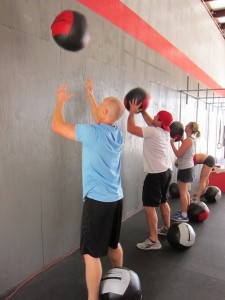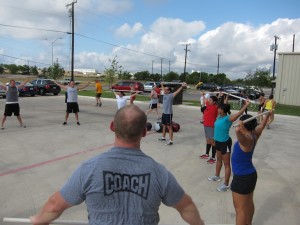 This post is part of an ongoing discussion about what churches can learn from CrossFit gyms.
This post is part of an ongoing discussion about what churches can learn from CrossFit gyms.
For context, read these two posts first:
My Health Club
The Problem With Many Churches
The CrossFit experience tends to be more personal than the typical big-box health club experience. When an athlete joins a CrossFit gym their experience will be similar to the introductory session at a big box gym. They’ll be weighed, measured, and pinched. A baseline fitness test will be given to establish a benchmark and instill some humility in the trainee. A “before” picture will be taken. A contract may be signed. Some CrossFit gyms use contracts and others don’t. A credit card number will be recorded or a check will be written. Arrangements will be made for “elements” or “on-ramp” sessions.
Most CrossFit gyms take new athletes through a series of classes designed to introduce them to the basic movements they’ll encounter in the WODs (Workout of the Day). These early sessions also give the trainers the opportunity to evaluate their athletes to determine their strengths and weaknesses. Some trainers will also devote time to helping each athlete establish goals for the first 30, 60, and 90 days of their training.
The best CrossFit gyms would never let their athletes join regular classes without putting them through these introductory sessions. Much like a 101 class functions at a church, they give the athletes an idea of what to expect from their training. And yes, some athletes go through elements and never come back because they realize more will be demanded of them than they expected.
None of this is all that different than what might happen at the introductory session at a big-box health club. It’s what happens after these initial sessions that makes the difference.
A typical CrossFit class is small, usually with no more than 15 athletes training at the same time. Every day, in every class, every athlete’s name is written on the white board next to the description of the workout. At the end of the workout, the athlete’s time or total weight lifted is written next to his or her name. It’s usually written by the trainer since after the WOD most CrossFitters lack the fine motor skill control necessary to write their name on a board with a marker. That, and many lose the ability to spell immediately after a WOD. (It usually returns within an hour.)
The “name on the board” practice is great for motivation, accountability, and competition. Those who workout at the end of the day can come in and see how well others have done on the WOD and what time they have to beat to claim a spot on the podium that day. Another benefit is that it takes away the possibility of anonymity.
You can’t work out at a CrossFit gym without having people learn your name. You can’t work out next to people day after day, week after week without it being noticed if you miss a class or two. You’ll probably get a call or text from your trainer. Better than that, you may get a playful message on Facebook from one of your classmates accusing you of skipping because the WOD was particularly tough that day.
CrossFit is more than communal, it’s personal. The CrossFit gym becomes a “third place” where everyone knows your name.
Because of the small trainer to athlete ratio—usually no greater than 1 to 15 in a single class and many times no greater than 1 to 50 in a single gym—each athlete receives personalized coaching throughout their training, not just during the first few sessions. This manageable span of care allows the trainer to give special attention to each athlete’s specific needs.
Under the watchful eye of a qualified trainer, athletes receive instant feedback during the workouts to improve their technique and form. Some athletes need to get stronger. They can easily get with their trainer to develop a plan for doing so. Some athletes need help with nutrition. Their trainer can point them to helpful resources or even sit down with them and help them formulate a meal plan.
This personalized approach to training has built-in accountability. If an athlete has been regularly showing up and working hard and yet is not improving, she can expect her trainer to initiate a conversation about her lack of progress. They may end up talking about quality of sleep, stress at work, or nutrition (usually all of the above).
There is an assumption on the part of the trainer that anyone doing CrossFit wants to get better. It is unacceptable for an athlete to keep showing up without getting results. The trainer expects the athlete to improve. The trainer expects the athlete to expect to improve. If there isn’t improvement, the trainer is there to help make the necessary tweaks until there is. This is a key insight into the CrossFit culture. Transformation is not a happy accident. It is expected, even guaranteed. (We’ll unpack this in a future post.)
 So much of this is about motivation. Some of us are motivated by the competition or camaraderie or the desire to achieve a goal. Having someone take a personal interest in your development as an athlete also has a powerful motivational effect. In some cases, athletes push themselves harder and continue to improve because they don’t want to disappoint their trainer who knows their name, remembers their goals, and notices when they miss a class.
So much of this is about motivation. Some of us are motivated by the competition or camaraderie or the desire to achieve a goal. Having someone take a personal interest in your development as an athlete also has a powerful motivational effect. In some cases, athletes push themselves harder and continue to improve because they don’t want to disappoint their trainer who knows their name, remembers their goals, and notices when they miss a class.




Wade,
Great post. My question is how do we get a church that has never been “personal” to become “personal”?
Jerrad–I don’t know. I wish I did. I’ve got a few ideas that I’ll offer in a future post.